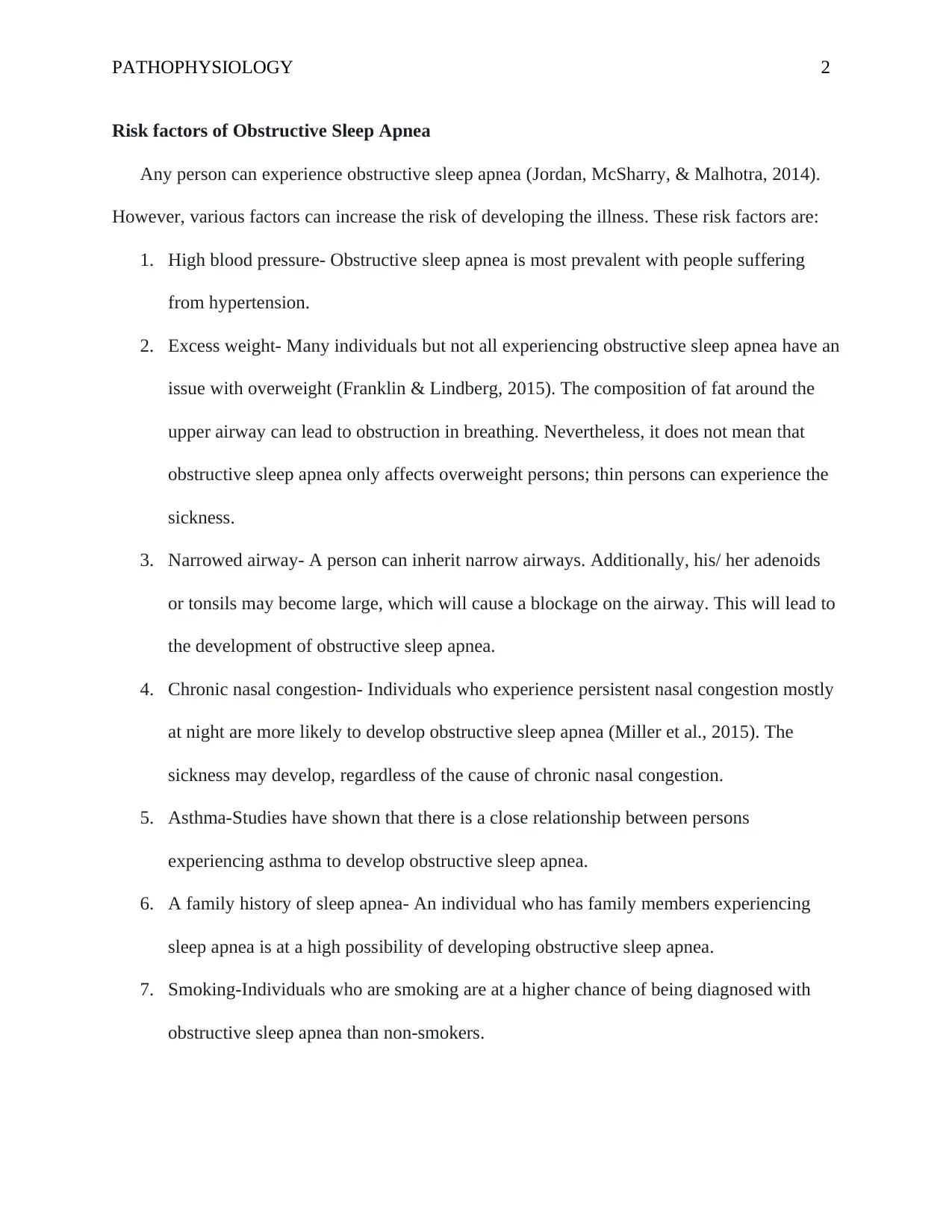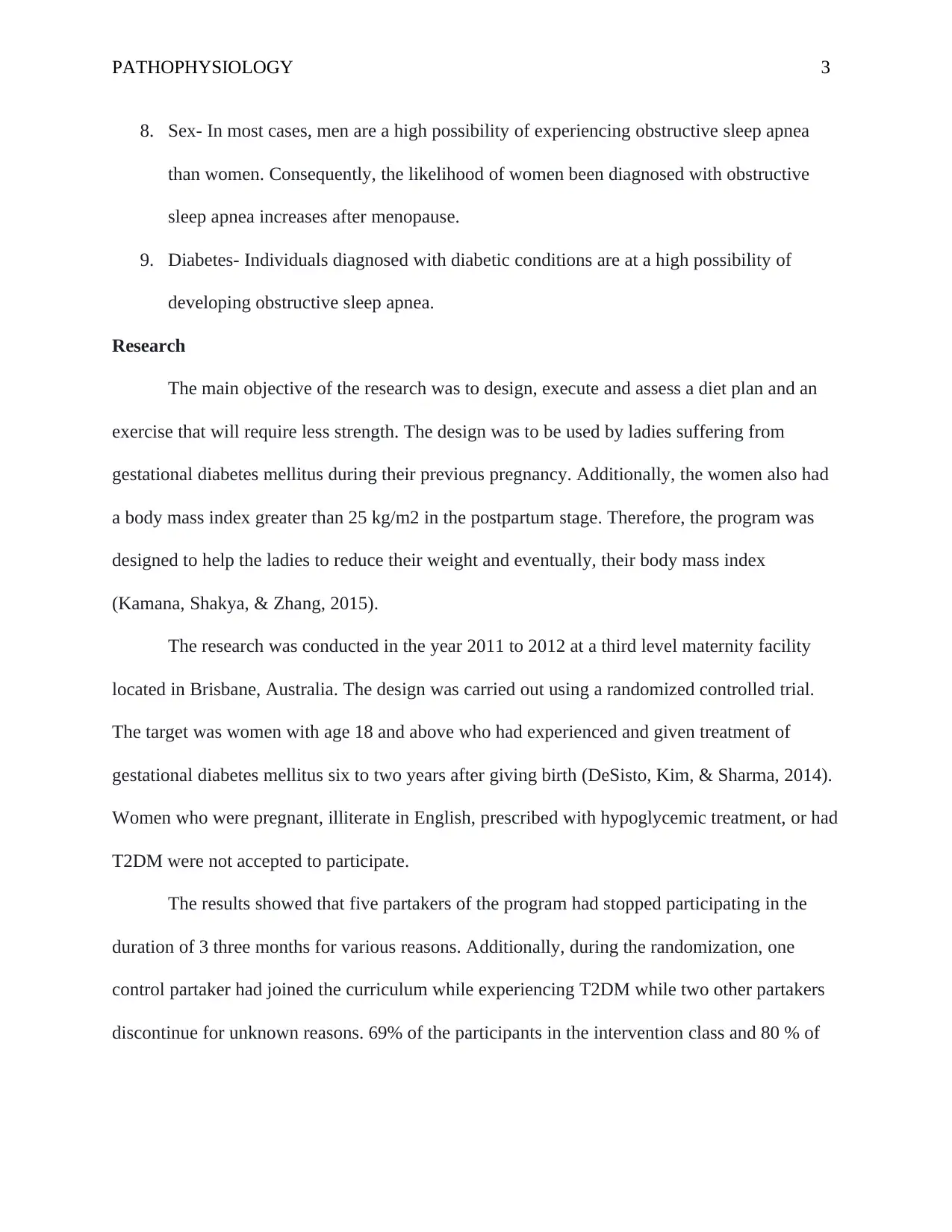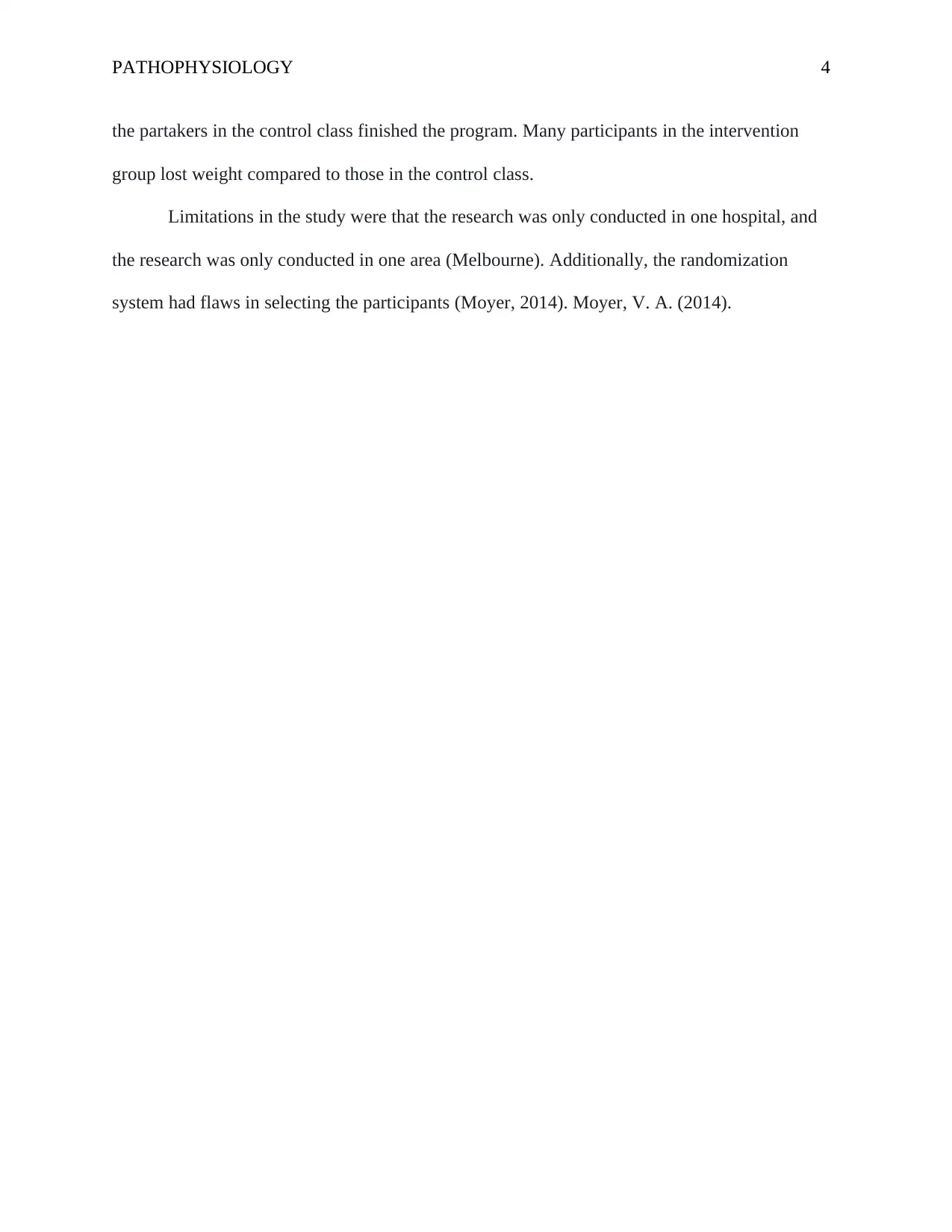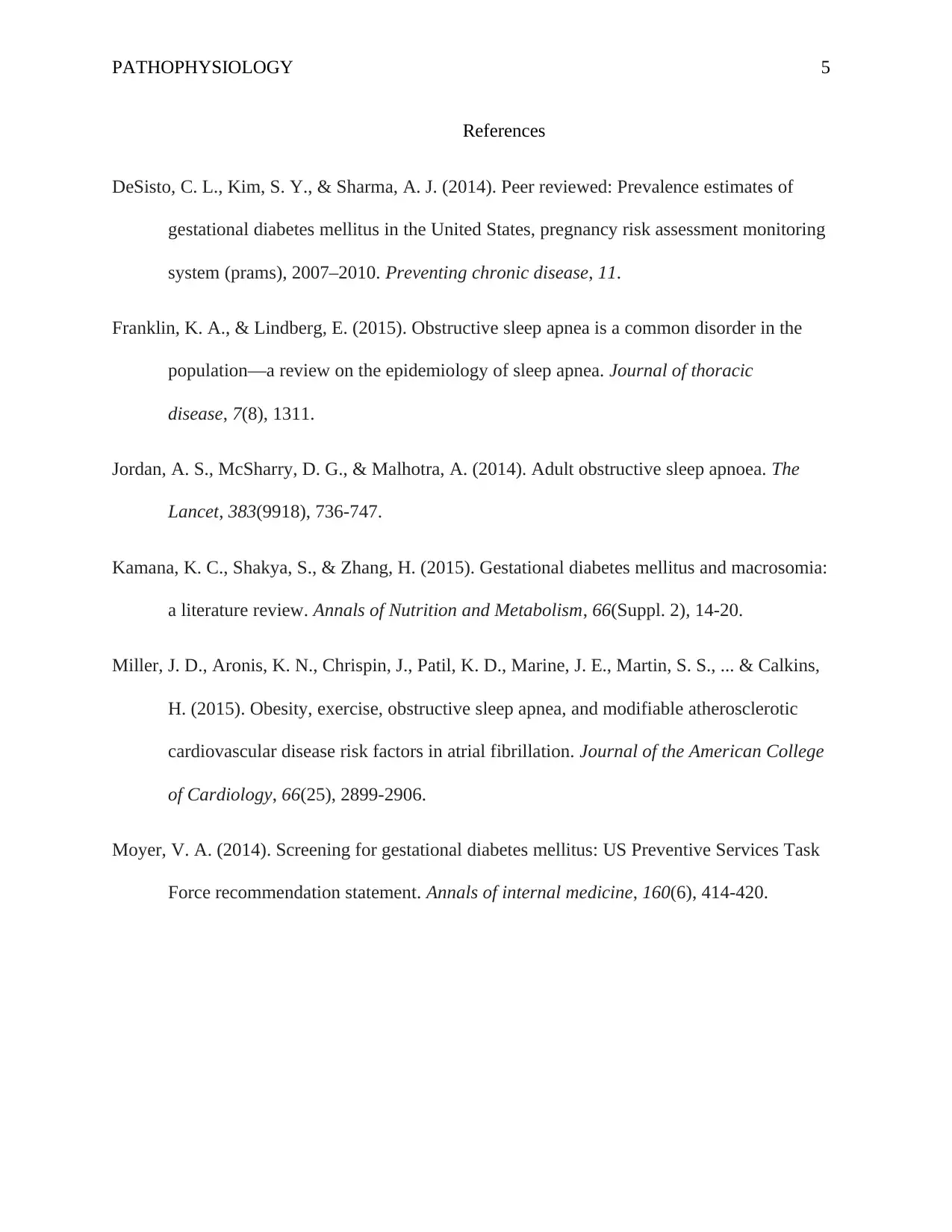Pathophysiology Report: Risk Factors and Research on Sleep Apnea
VerifiedAdded on 2022/10/17
|5
|939
|15
Report
AI Summary
This report explores the risk factors associated with obstructive sleep apnea (OSA), including hypertension, excess weight, narrowed airways, chronic nasal congestion, asthma, family history, smoking, sex, and diabetes. The report also summarizes a research study that aimed to design, implement, and assess a low-intensity diet and exercise plan for women with a history of gestational diabetes mellitus (GDM) and a BMI greater than 25 kg/m2 in the postpartum stage. The study, conducted in Brisbane, Australia, used a randomized controlled trial to help women reduce weight and BMI. The results indicated weight loss in the intervention group compared to the control group, while also pointing out limitations such as the study's single-site location and flaws in the randomization process.

Running head: PATHOPHYSIOLOGY 1
Pathophysiology
Name of Author
Institution of Affiliation
Date of Submission
Pathophysiology
Name of Author
Institution of Affiliation
Date of Submission
Paraphrase This Document
Need a fresh take? Get an instant paraphrase of this document with our AI Paraphraser

PATHOPHYSIOLOGY 2
Risk factors of Obstructive Sleep Apnea
Any person can experience obstructive sleep apnea (Jordan, McSharry, & Malhotra, 2014).
However, various factors can increase the risk of developing the illness. These risk factors are:
1. High blood pressure- Obstructive sleep apnea is most prevalent with people suffering
from hypertension.
2. Excess weight- Many individuals but not all experiencing obstructive sleep apnea have an
issue with overweight (Franklin & Lindberg, 2015). The composition of fat around the
upper airway can lead to obstruction in breathing. Nevertheless, it does not mean that
obstructive sleep apnea only affects overweight persons; thin persons can experience the
sickness.
3. Narrowed airway- A person can inherit narrow airways. Additionally, his/ her adenoids
or tonsils may become large, which will cause a blockage on the airway. This will lead to
the development of obstructive sleep apnea.
4. Chronic nasal congestion- Individuals who experience persistent nasal congestion mostly
at night are more likely to develop obstructive sleep apnea (Miller et al., 2015). The
sickness may develop, regardless of the cause of chronic nasal congestion.
5. Asthma-Studies have shown that there is a close relationship between persons
experiencing asthma to develop obstructive sleep apnea.
6. A family history of sleep apnea- An individual who has family members experiencing
sleep apnea is at a high possibility of developing obstructive sleep apnea.
7. Smoking-Individuals who are smoking are at a higher chance of being diagnosed with
obstructive sleep apnea than non-smokers.
Risk factors of Obstructive Sleep Apnea
Any person can experience obstructive sleep apnea (Jordan, McSharry, & Malhotra, 2014).
However, various factors can increase the risk of developing the illness. These risk factors are:
1. High blood pressure- Obstructive sleep apnea is most prevalent with people suffering
from hypertension.
2. Excess weight- Many individuals but not all experiencing obstructive sleep apnea have an
issue with overweight (Franklin & Lindberg, 2015). The composition of fat around the
upper airway can lead to obstruction in breathing. Nevertheless, it does not mean that
obstructive sleep apnea only affects overweight persons; thin persons can experience the
sickness.
3. Narrowed airway- A person can inherit narrow airways. Additionally, his/ her adenoids
or tonsils may become large, which will cause a blockage on the airway. This will lead to
the development of obstructive sleep apnea.
4. Chronic nasal congestion- Individuals who experience persistent nasal congestion mostly
at night are more likely to develop obstructive sleep apnea (Miller et al., 2015). The
sickness may develop, regardless of the cause of chronic nasal congestion.
5. Asthma-Studies have shown that there is a close relationship between persons
experiencing asthma to develop obstructive sleep apnea.
6. A family history of sleep apnea- An individual who has family members experiencing
sleep apnea is at a high possibility of developing obstructive sleep apnea.
7. Smoking-Individuals who are smoking are at a higher chance of being diagnosed with
obstructive sleep apnea than non-smokers.

PATHOPHYSIOLOGY 3
8. Sex- In most cases, men are a high possibility of experiencing obstructive sleep apnea
than women. Consequently, the likelihood of women been diagnosed with obstructive
sleep apnea increases after menopause.
9. Diabetes- Individuals diagnosed with diabetic conditions are at a high possibility of
developing obstructive sleep apnea.
Research
The main objective of the research was to design, execute and assess a diet plan and an
exercise that will require less strength. The design was to be used by ladies suffering from
gestational diabetes mellitus during their previous pregnancy. Additionally, the women also had
a body mass index greater than 25 kg/m2 in the postpartum stage. Therefore, the program was
designed to help the ladies to reduce their weight and eventually, their body mass index
(Kamana, Shakya, & Zhang, 2015).
The research was conducted in the year 2011 to 2012 at a third level maternity facility
located in Brisbane, Australia. The design was carried out using a randomized controlled trial.
The target was women with age 18 and above who had experienced and given treatment of
gestational diabetes mellitus six to two years after giving birth (DeSisto, Kim, & Sharma, 2014).
Women who were pregnant, illiterate in English, prescribed with hypoglycemic treatment, or had
T2DM were not accepted to participate.
The results showed that five partakers of the program had stopped participating in the
duration of 3 three months for various reasons. Additionally, during the randomization, one
control partaker had joined the curriculum while experiencing T2DM while two other partakers
discontinue for unknown reasons. 69% of the participants in the intervention class and 80 % of
8. Sex- In most cases, men are a high possibility of experiencing obstructive sleep apnea
than women. Consequently, the likelihood of women been diagnosed with obstructive
sleep apnea increases after menopause.
9. Diabetes- Individuals diagnosed with diabetic conditions are at a high possibility of
developing obstructive sleep apnea.
Research
The main objective of the research was to design, execute and assess a diet plan and an
exercise that will require less strength. The design was to be used by ladies suffering from
gestational diabetes mellitus during their previous pregnancy. Additionally, the women also had
a body mass index greater than 25 kg/m2 in the postpartum stage. Therefore, the program was
designed to help the ladies to reduce their weight and eventually, their body mass index
(Kamana, Shakya, & Zhang, 2015).
The research was conducted in the year 2011 to 2012 at a third level maternity facility
located in Brisbane, Australia. The design was carried out using a randomized controlled trial.
The target was women with age 18 and above who had experienced and given treatment of
gestational diabetes mellitus six to two years after giving birth (DeSisto, Kim, & Sharma, 2014).
Women who were pregnant, illiterate in English, prescribed with hypoglycemic treatment, or had
T2DM were not accepted to participate.
The results showed that five partakers of the program had stopped participating in the
duration of 3 three months for various reasons. Additionally, during the randomization, one
control partaker had joined the curriculum while experiencing T2DM while two other partakers
discontinue for unknown reasons. 69% of the participants in the intervention class and 80 % of
⊘ This is a preview!⊘
Do you want full access?
Subscribe today to unlock all pages.

Trusted by 1+ million students worldwide

PATHOPHYSIOLOGY 4
the partakers in the control class finished the program. Many participants in the intervention
group lost weight compared to those in the control class.
Limitations in the study were that the research was only conducted in one hospital, and
the research was only conducted in one area (Melbourne). Additionally, the randomization
system had flaws in selecting the participants (Moyer, 2014). Moyer, V. A. (2014).
the partakers in the control class finished the program. Many participants in the intervention
group lost weight compared to those in the control class.
Limitations in the study were that the research was only conducted in one hospital, and
the research was only conducted in one area (Melbourne). Additionally, the randomization
system had flaws in selecting the participants (Moyer, 2014). Moyer, V. A. (2014).
Paraphrase This Document
Need a fresh take? Get an instant paraphrase of this document with our AI Paraphraser

PATHOPHYSIOLOGY 5
References
DeSisto, C. L., Kim, S. Y., & Sharma, A. J. (2014). Peer reviewed: Prevalence estimates of
gestational diabetes mellitus in the United States, pregnancy risk assessment monitoring
system (prams), 2007–2010. Preventing chronic disease, 11.
Franklin, K. A., & Lindberg, E. (2015). Obstructive sleep apnea is a common disorder in the
population—a review on the epidemiology of sleep apnea. Journal of thoracic
disease, 7(8), 1311.
Jordan, A. S., McSharry, D. G., & Malhotra, A. (2014). Adult obstructive sleep apnoea. The
Lancet, 383(9918), 736-747.
Kamana, K. C., Shakya, S., & Zhang, H. (2015). Gestational diabetes mellitus and macrosomia:
a literature review. Annals of Nutrition and Metabolism, 66(Suppl. 2), 14-20.
Miller, J. D., Aronis, K. N., Chrispin, J., Patil, K. D., Marine, J. E., Martin, S. S., ... & Calkins,
H. (2015). Obesity, exercise, obstructive sleep apnea, and modifiable atherosclerotic
cardiovascular disease risk factors in atrial fibrillation. Journal of the American College
of Cardiology, 66(25), 2899-2906.
Moyer, V. A. (2014). Screening for gestational diabetes mellitus: US Preventive Services Task
Force recommendation statement. Annals of internal medicine, 160(6), 414-420.
References
DeSisto, C. L., Kim, S. Y., & Sharma, A. J. (2014). Peer reviewed: Prevalence estimates of
gestational diabetes mellitus in the United States, pregnancy risk assessment monitoring
system (prams), 2007–2010. Preventing chronic disease, 11.
Franklin, K. A., & Lindberg, E. (2015). Obstructive sleep apnea is a common disorder in the
population—a review on the epidemiology of sleep apnea. Journal of thoracic
disease, 7(8), 1311.
Jordan, A. S., McSharry, D. G., & Malhotra, A. (2014). Adult obstructive sleep apnoea. The
Lancet, 383(9918), 736-747.
Kamana, K. C., Shakya, S., & Zhang, H. (2015). Gestational diabetes mellitus and macrosomia:
a literature review. Annals of Nutrition and Metabolism, 66(Suppl. 2), 14-20.
Miller, J. D., Aronis, K. N., Chrispin, J., Patil, K. D., Marine, J. E., Martin, S. S., ... & Calkins,
H. (2015). Obesity, exercise, obstructive sleep apnea, and modifiable atherosclerotic
cardiovascular disease risk factors in atrial fibrillation. Journal of the American College
of Cardiology, 66(25), 2899-2906.
Moyer, V. A. (2014). Screening for gestational diabetes mellitus: US Preventive Services Task
Force recommendation statement. Annals of internal medicine, 160(6), 414-420.
1 out of 5
Your All-in-One AI-Powered Toolkit for Academic Success.
+13062052269
info@desklib.com
Available 24*7 on WhatsApp / Email
![[object Object]](/_next/static/media/star-bottom.7253800d.svg)
Unlock your academic potential
Copyright © 2020–2025 A2Z Services. All Rights Reserved. Developed and managed by ZUCOL.
